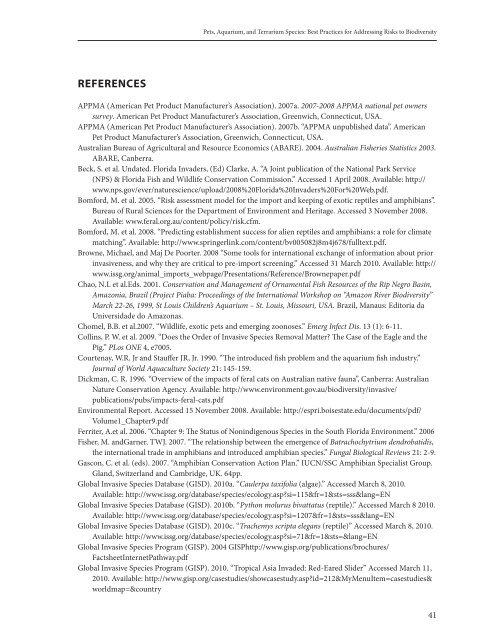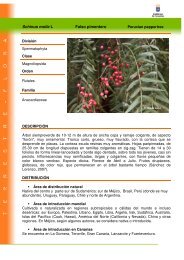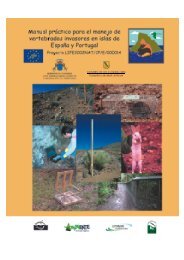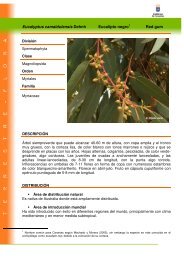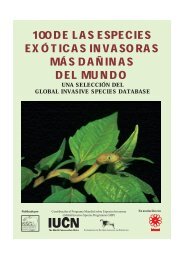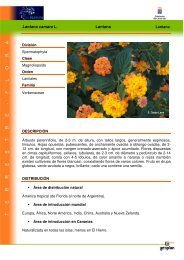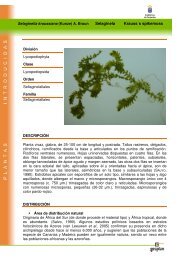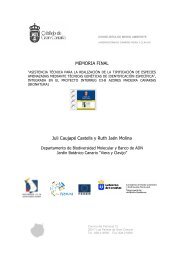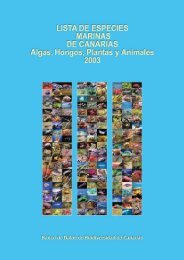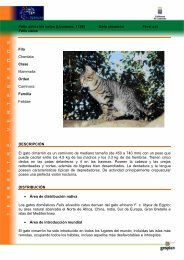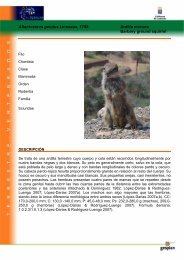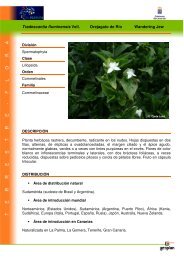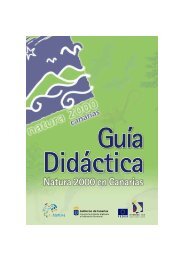Pets, Aquarium, and Terrarium Species - Convention on Biological ...
Pets, Aquarium, and Terrarium Species - Convention on Biological ...
Pets, Aquarium, and Terrarium Species - Convention on Biological ...
You also want an ePaper? Increase the reach of your titles
YUMPU automatically turns print PDFs into web optimized ePapers that Google loves.
<str<strong>on</strong>g>Pets</str<strong>on</strong>g>, <str<strong>on</strong>g>Aquarium</str<strong>on</strong>g>, <str<strong>on</strong>g>and</str<strong>on</strong>g> <str<strong>on</strong>g>Terrarium</str<strong>on</strong>g> <str<strong>on</strong>g>Species</str<strong>on</strong>g>: Best Practices for Addressing Risks to Biodiversity<br />
REFERENCES<br />
APPMA (American Pet Product Manufacturer’s Associati<strong>on</strong>). 2007a. 2007-2008 APPMA nati<strong>on</strong>al pet owners<br />
survey. American Pet Product Manufacturer’s Associati<strong>on</strong>, Greenwich, C<strong>on</strong>necticut, USA.<br />
APPMA (American Pet Product Manufacturer’s Associati<strong>on</strong>). 2007b. “APPMA unpublished data”. American<br />
Pet Product Manufacturer’s Associati<strong>on</strong>, Greenwich, C<strong>on</strong>necticut, USA.<br />
Australian Bureau of Agricultural <str<strong>on</strong>g>and</str<strong>on</strong>g> Resource Ec<strong>on</strong>omics (ABARE). 2004. Australian Fisheries Statistics 2003.<br />
ABARE, Canberra.<br />
Beck, S. et al. Undated. Florida Invaders, (Ed) Clarke, A. “A Joint publicati<strong>on</strong> of the Nati<strong>on</strong>al Park Service<br />
(NPS) & Florida Fish <str<strong>on</strong>g>and</str<strong>on</strong>g> Wildlife C<strong>on</strong>servati<strong>on</strong> Commissi<strong>on</strong>.” Accessed 1 April 2008. Available: http://<br />
www.nps.gov/ever/naturescience/upload/2008%20Florida%20Invaders%20For%20Web.pdf.<br />
Bomford, M. et al. 2005. “Risk assessment model for the import <str<strong>on</strong>g>and</str<strong>on</strong>g> keeping of exotic reptiles <str<strong>on</strong>g>and</str<strong>on</strong>g> amphibians”.<br />
Bureau of Rural Sciences for the Department of Envir<strong>on</strong>ment <str<strong>on</strong>g>and</str<strong>on</strong>g> Heritage. Accessed 3 November 2008.<br />
Available: www.feral.org.au/c<strong>on</strong>tent/policy/risk.cfm.<br />
Bomford, M. et al. 2008. “Predicting establishment success for alien reptiles <str<strong>on</strong>g>and</str<strong>on</strong>g> amphibians: a role for climate<br />
matching”. Available: http://www.springerlink.com/c<strong>on</strong>tent/bv005082j8m4j678/fulltext.pdf.<br />
Browne, Michael, <str<strong>on</strong>g>and</str<strong>on</strong>g> Maj De Poorter. 2008 “Some tools for internati<strong>on</strong>al exchange of informati<strong>on</strong> about prior<br />
invasiveness, <str<strong>on</strong>g>and</str<strong>on</strong>g> why they are critical to pre-import screening.” Accessed 31 March 2010. Available: http://<br />
www.issg.org/animal_imports_webpage/Presentati<strong>on</strong>s/Reference/Brownepaper.pdf<br />
Chao, N.L et al.Eds. 2001. C<strong>on</strong>servati<strong>on</strong> <str<strong>on</strong>g>and</str<strong>on</strong>g> Management of Ornamental Fish Resources of the Rip Negro Basin,<br />
Amaz<strong>on</strong>ia, Brazil (Project Piaba: Proceedings of the Internati<strong>on</strong>al Workshop <strong>on</strong> “Amaz<strong>on</strong> River Biodiversity”<br />
March 22-26, 1999, St Louis Children’s <str<strong>on</strong>g>Aquarium</str<strong>on</strong>g> – St. Louis, Missouri, USA. Brazil, Manaus: Editoria da<br />
Universidade do Amaz<strong>on</strong>as.<br />
Chomel, B.B. et al.2007. “Wildlife, exotic pets <str<strong>on</strong>g>and</str<strong>on</strong>g> emerging zo<strong>on</strong>oses.” Emerg Infect Dis. 13 (1): 6-11.<br />
Collins, P. W. et al. 2009. “Does the Order of Invasive <str<strong>on</strong>g>Species</str<strong>on</strong>g> Removal Matter? The Case of the Eagle <str<strong>on</strong>g>and</str<strong>on</strong>g> the<br />
Pig.” PLos ONE 4, e7005.<br />
Courtenay, W.R. Jr <str<strong>on</strong>g>and</str<strong>on</strong>g> Stauffer JR, Jr. 1990. “The introduced fish problem <str<strong>on</strong>g>and</str<strong>on</strong>g> the aquarium fish industry.”<br />
Journal of World Aquaculture Society 21: 145-159.<br />
Dickman, C. R. 1996. “Overview of the impacts of feral cats <strong>on</strong> Australian native fauna”, Canberra: Australian<br />
Nature C<strong>on</strong>servati<strong>on</strong> Agency. Available: http://www.envir<strong>on</strong>ment.gov.au/biodiversity/invasive/<br />
publicati<strong>on</strong>s/pubs/impacts-feral-cats.pdf<br />
Envir<strong>on</strong>mental Report. Accessed 15 November 2008. Available: http://espri.boisestate.edu/documents/pdf/<br />
Volume1_Chapter9.pdf<br />
Ferriter, A.et al. 2006. “Chapter 9: The Status of N<strong>on</strong>indigenous <str<strong>on</strong>g>Species</str<strong>on</strong>g> in the South Florida Envir<strong>on</strong>ment.” 2006<br />
Fisher, M. <str<strong>on</strong>g>and</str<strong>on</strong>g>Garner, TWJ. 2007. “The relati<strong>on</strong>ship between the emergence of Batrachochytrium dendrobatidis,<br />
the internati<strong>on</strong>al trade in amphibians <str<strong>on</strong>g>and</str<strong>on</strong>g> introduced amphibian species.” Fungal <strong>Biological</strong> Reviews 21: 2-9.<br />
Gasc<strong>on</strong>, C. et al. (eds). 2007. “Amphibian C<strong>on</strong>servati<strong>on</strong> Acti<strong>on</strong> Plan.” IUCN/SSC Amphibian Specialist Group.<br />
Gl<str<strong>on</strong>g>and</str<strong>on</strong>g>, Switzerl<str<strong>on</strong>g>and</str<strong>on</strong>g> <str<strong>on</strong>g>and</str<strong>on</strong>g> Cambridge, UK. 64pp.<br />
Global Invasive <str<strong>on</strong>g>Species</str<strong>on</strong>g> Database (GISD). 2010a. “Caulerpa taxifolia (algae).” Accessed March 8, 2010.<br />
Available: http://www.issg.org/database/species/ecology.asp?si=115&fr=1&sts=sss&lang=EN<br />
Global Invasive <str<strong>on</strong>g>Species</str<strong>on</strong>g> Database (GISD). 2010b. “Pyth<strong>on</strong> molurus bivattatus (reptile).” Accessed March 8 2010.<br />
Available: http://www.issg.org/database/species/ecology.asp?si=1207&fr=1&sts=sss&lang=EN<br />
Global Invasive <str<strong>on</strong>g>Species</str<strong>on</strong>g> Database (GISD). 2010c. “Trachemys scripta elegans (reptile)” Accessed March 8, 2010.<br />
Available: http://www.issg.org/database/species/ecology.asp?si=71&fr=1&sts=&lang=EN<br />
Global Invasive <str<strong>on</strong>g>Species</str<strong>on</strong>g> Program (GISP). 2004 GISPhttp://www.gisp.org/publicati<strong>on</strong>s/brochures/<br />
FactsheetInternetPathway.pdf<br />
Global Invasive <str<strong>on</strong>g>Species</str<strong>on</strong>g> Program (GISP). 2010. “Tropical Asia Invaded: Red-Eared Slider” Accessed March 11,<br />
2010. Available: http://www.gisp.org/casestudies/showcasestudy.asp?id=212&MyMenuItem=casestudies&<br />
worldmap=&country<br />
41


